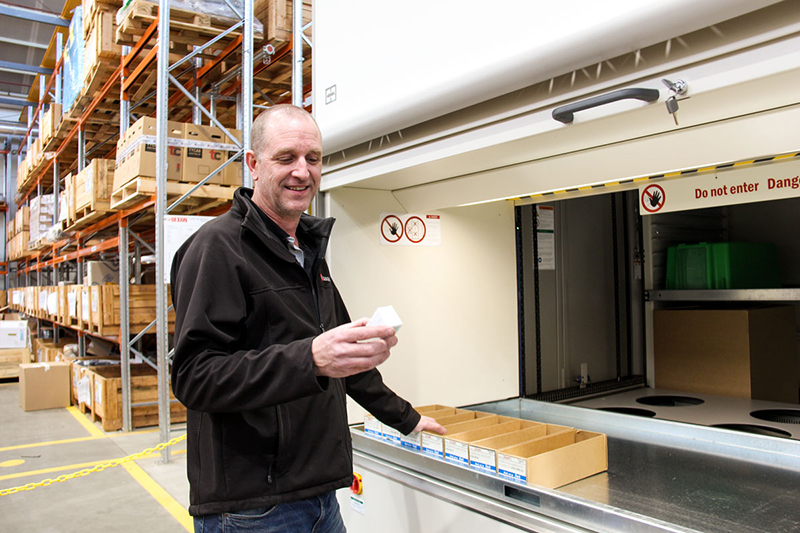3 must-haves for super-fast equipment repair
Bruno Valenta, Published: August 18, 2017 - Updated: August 7, 2019 (7 min read)
Equipment failure costs businesses millions of dollars annually, and can even have consequences on the future of the business, as plant operators can be so busy trying to repair equipment and get it back up and running that they miss opportunities for improvements that help future-proof production.
So what can be done today to help you fix problems quicker tomorrow? We asked our National Service Manager, Deon McHatton for his tips.
Q. What are your top three strategies for fast equipment repairs?
A. If we're talking in terms of plant equipment, then you should:
- Have spares available
- Have on-site documentation on how equipment should operate
- Have up-to-date drawings
All three need to be close at hand and available to experienced staff. I can't stress this enough.
Repairing a PLC or automation system, on the other hand, is much more complex and the strategy will depend on the brand and your vendor support.
Q. What are the common mistakes that manufacturers make when it comes to equipment management?
A. Some plants have no drawings, they have nothing written down on how equipment is supposed to operate and they employ casual operators so even the operators are unfamiliar with the equipment. This is the trifecta of what not to do. It’s the perfect storm. These plants can pour tens of thousands down the drain in failure events because they’re not prepared.
Q. What's the most underrated strategy for getting lightning-speed equipment repairs?
A. Spares, documentation and drawings are critical for getting operations back on track in the event of equipment failure. But one underrated strategy is organisation and labelling.
If the right spare is in stock, but it's hidden away in storage somewhere, that's time lost in hunting for it. Keep spares on hand, labelled and organised. Better yet standardise your spares for simpler management and reduced capital expenditure.
The same goes for drawing and documentation. If a machine goes down and a technician has to fix it, he/she needs to have access to the machine's history, past behaviour, flow rates, design and maintenance records. These must be on hand, up to date, and ordered logically so that any internal or external technician can get to work right away.
Q. Can’t a service provider get my equipment back up when it fails?
A. Yes, a service provider can get you back up and running; for example, SAGE offers 24/7 on-site breakdown support. But, regardless of whether it’s an in-house or external technician trying to resolve the problem, you still need to have your spare parts, documentation and drawings on hand to be able to fix the issue in the quickest way.
This flows from having equipment criticality rating and redundancy plans in place in the event of failures, as well as a sound preventative maintenance plan. Being prepared will get production back up running faster and save the business from lost time, money and reputation.
Q. These strategies all seem important, but not urgent in the face of day-to-day production demands. How do you suggest busy plant, maintenance or engineering managers work on these strategies?
A. The financial incentives alone should be enough to make the business pause. Present a business case to upper management for support and resourcing – if that’s what you need. Investing time and money in smart approaches like parts standardisation, or getting your drawings and documentation up-to-date will save you in downtime costs.
With upper management’s support, you’ll be more likely to make time to build these strategies into your day to day and filter this mentality down to your staff. Documentation is everyone’s responsibility.
Q. How do I show that these strategies will save the business time and money?
A.
- Calculate downtime costs in dollar terms
- Do an equipment criticality rating or use your current criticality rating to show the potential loss in production if critical equipment goes down
- Calculate the cost of updating drawings, documentation and standardising your parts – this will be considerably less or next to nothing if you can build these practices into your employees’ day-to-day.
Q. Why is it so important to have spare parts on hand?
A. Some pieces of equipment sold in Australia use imported spares. We've had cases in the past when a plant was down for 6–12 weeks waiting for a replacement part. Knowing which parts are hard to get hold of, and having them on hand will save you this trouble.
Q. What’s an example of how up-to-date documentation can save time?
A. It can take quite some time to work through the program and understand how the machine operates to allow for troubleshooting – referring to an operations manual reduces this effort considerably.
But if the program has no comments the time spent working through the code to understand how things are operating is sometimes four to five times more than when working with a commented program.
Q. Why is it so important to have up-to-date drawings?
A. Take a simple packaging machine: it can take hours to trace the wiring to allow for simple troubleshooting. Referring to accurate drawings, on the other hand, would take a matter of minutes.
Q. What if I just don’t have the time to apply these strategies?
A. SAGE Automation’s experienced technicians can work with you to complete site audits, parts and equipment standardisation, machine criticality assessments, compliance testing, and technical service support drawing. This’ll better prepare you for failures and help gain support from management. Actually knowing the risks is different to thinking they might exist and ignoring them.
And in the event of equipment failure, SAGE’s 24/7 critical on-site breakdown support, help desk and non-critical fault resolution ensures you’ll be up and running quicker than you can say *sugar*.
Q. Whose responsibility is equipment repairs?
A. I believe the business owner, or manager has the ultimate responsibility. Equipment might come under the maintenance, engineering or production manager's department, but at the end of the day the responsibility always flows up.
The business should have trustworthy, competent people that take care of the way equipment is managed and ensure equipment is safe for employees to work on. It’s also important to empower staff to take ownership of equipment and other improvement processes.
You can't outsource the responsibility for safety and you can't outsource the responsibility for keeping the plant going: it’s everyone’s job.
I like to see SAGE as a partner to every business – we can work with you to develop standards, get redundancies in place and make you better prepared for failure, but ultimately the responsibility is yours.
Q. Any last advice?
A. It’s really about assessing risk and being prepared. The simple stuff will always have the biggest impact.
Remember: spares, on-site documentation and up-to-date drawings are the first steps to fast equipment repair.
Can your plant recover quickly from costly equipment failure? SAGE can help you put in place the strategies you need to get your production back online in the shortest possible time. Contact us today to see what we can do for your business.
When a machine stops, it can quickly escalate to calling in external help – sometimes unnecessarily. The Breakdown Checklist is designed to get you back online faster. It will get your team thinking about what caused the breakdown and assess the need for external advice. Download the free downtime checklist here.
SAGE Automation delivers agile, scalable and secure solutions that don’t just solve current problems, they pre-empt and deter future ones, helping your organisation thrive. With years of experience working in defence, infrastructure, resources, utilities and manufacturing we have the expertise you need to custom-build or perform manufacturing maintenance on your equipment for maximum ROI.








